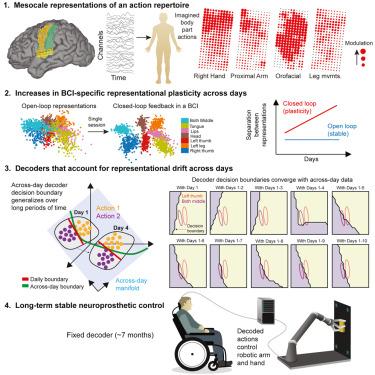Sampling representational plasticity of simple imagined movements across days enables long-term neuroprosthetic control
IF 45.5
1区 生物学
Q1 BIOCHEMISTRY & MOLECULAR BIOLOGY
引用次数: 0
Abstract
The nervous system needs to balance the stability of neural representations with plasticity. It is unclear what the representational stability of simple well-rehearsed actions is, particularly in humans, and their adaptability to new contexts. Using an electrocorticography brain-computer interface (BCI) in tetraplegic participants, we found that the low-dimensional manifold and relative representational distances for a repertoire of simple imagined movements were remarkably stable. The manifold’s absolute location, however, demonstrated constrained day-to-day drift. Strikingly, neural statistics, especially variance, could be flexibly regulated to increase representational distances during BCI control without somatotopic changes. Discernability strengthened with practice and was BCI-specific, demonstrating contextual specificity. Sampling representational plasticity and drift across days subsequently uncovered a meta-representational structure with generalizable decision boundaries for the repertoire; this allowed long-term neuroprosthetic control of a robotic arm and hand for reaching and grasping. Our study offers insights into mesoscale representational statistics that also enable long-term complex neuroprosthetic control.

求助全文
约1分钟内获得全文
求助全文
来源期刊

Cell
生物-生化与分子生物学
CiteScore
110.00
自引率
0.80%
发文量
396
审稿时长
2 months
期刊介绍:
Cells is an international, peer-reviewed, open access journal that focuses on cell biology, molecular biology, and biophysics. It is affiliated with several societies, including the Spanish Society for Biochemistry and Molecular Biology (SEBBM), Nordic Autophagy Society (NAS), Spanish Society of Hematology and Hemotherapy (SEHH), and Society for Regenerative Medicine (Russian Federation) (RPO).
The journal publishes research findings of significant importance in various areas of experimental biology, such as cell biology, molecular biology, neuroscience, immunology, virology, microbiology, cancer, human genetics, systems biology, signaling, and disease mechanisms and therapeutics. The primary criterion for considering papers is whether the results contribute to significant conceptual advances or raise thought-provoking questions and hypotheses related to interesting and important biological inquiries.
In addition to primary research articles presented in four formats, Cells also features review and opinion articles in its "leading edge" section, discussing recent research advancements and topics of interest to its wide readership.
 求助内容:
求助内容: 应助结果提醒方式:
应助结果提醒方式:


